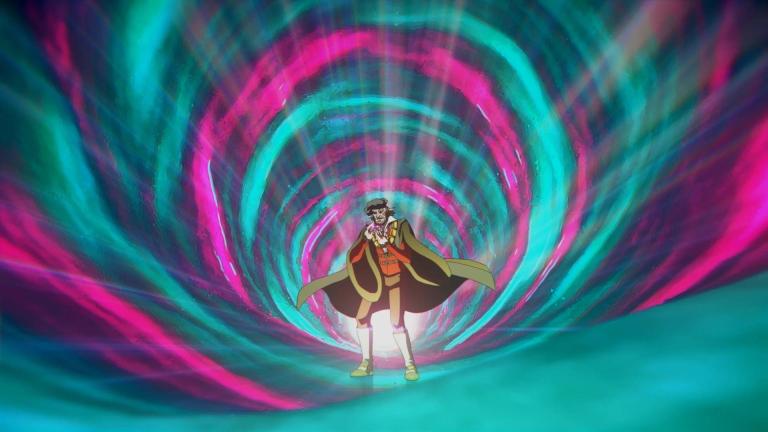Castlevania Season 3: Infinite Corridor Explained
The Infinite Corridor is one of the central mysteries of Castlevania season 3. Let's unpack what the Infinite Corridor means for the future of the show.

Castlevania season 3 has come and gone. Long did fans wait for the third season of the animated series, and after just 10 half-hour episodes of monster-hunting adventures, we’re left to wait again. Unlike season 2, which tied up its Dracula storyline in a neat, blood-stained bow, season 3 leaves viewers with more questions than answers.
One of the central mysteries of the season is the origin and function of the Infinite Corridor, an alternate plane that contains doors to different points in time (and perhaps even dimensions) across the Castlevania universe. It’s with the Infinite Corridor that creepy Dracula acolyte Prior Sala hopes to open a door to Hell and bring the Dark Lord back from the dead.
Longtime fans of the Castlevania franchise will undoubtedly recognize the Infinite Corridor, which is taken straight from the games. It was first introduced in 2005’s Curse of Darkness as an alternate dimension where protagonist Hector fights the headless knight Dullahan, a boss who’s appeared in many of the games. But the lore of the Infinite Corridor in the game isn’t quite as fleshed out as what the animated series establishes in season 3.
In the Netflix series, the wise Count Saint Germain explains that the Infinite Corridor is a “route to many other worlds, and it’s certainly possible that one of them is Hell. However, in the experience of those of [his] particular expertise, it is in fact a system of doors to other lands, separated from our own by space and time. Portals to the Corridor are few and far between, and they drift in and out of existence.”
In episode 5 we get to see some of these other worlds, as Saint Germain tumbles through the Infinite Corridor in a psychedelic dream that leads him to doors showing him several other points in time (or possibly other worlds). These visions may be the key to unlocking how the Infinite Corridor will change the show going forward.
For one thing, it may allow the writer Warren Ellis, director Sam Deats, and the rest of the Netflix team to explore other eras of the Castlevania franchise, which spans hundreds of years and follows several generations of Belmonts and other monster hunters in their fight against Dracula. In fact, Saint Germain’s dream teases at least two possible eras or storylines that could be explored through the Infinite Corridor.
At one point in the dream, Saint Germain is shown a strange vision of the future where what looks like a bipedal mech walks across a desert. This could be a nod to the year 2035, the futuristic setting of Aria of Sorrow and Dawn of Sorrow, the duology of games starring fan-favorite hero Soma Cruz, a character who’s been mentioned in connection to the animated series before.
Adi Shankar, executive producer of the animated series, previously told IGN in 2018 that he’s really fond of Soma as a character.
“When you look at the story of Soma Cruz, and really what we’re doing here, the difference between the gaming universe and the Castlevania cinematic universe, we are adding emotional depth, and to extrapolate from Soma Cruz there’s a lot to unpack there — and I’m not spoiling it, I’m just saying I personally just really dig Soma Cruz.”
This is in no way a confirmation that Soma is set to appear in the animated series, but it’s impossible to ignore the Sorrow games as a possible influence on this futuristic setting. Of course, this could just be an elaborate easter egg since Castlevania has remained a pretty self-contained series through its first three seasons.
Saint Germain also sees a pyramid in his dream, which could be a nod to Sandy Grave, an Egyptian-themed stage that appears in 2006’s Portrait of Ruin. How Portrait of Ruin could connect to the animated series is even hazier. That game and its predecessor, 1994’s Bloodlines, follow the Morrises, a different line of vampire killers who descend from the Belmonts. The other protagonist of Portrait of Ruin is Charlotte Aulin, a sorceress who descends from the Belnades clan.
If the animated series were to borrow directly from Portrait of Ruin and the Morris/Aulin storyline, it could add a new layer of complexity to Trevor and Sypha’s relationship. Season 3 establishes that the two heroes are now romantic and may even be in love, which, in the game continuity, sets in motion many more generations of Belmonts, including Simon Belmont, the hero of the first two Castlevania games for the NES.
Could the show perhaps send Trevor and Sypha through the Infinite Corridor to meet some of their successors? At a moment when both heroes feel hopeless after the fall of Lindenfeld, seeing how they’ll one day inspire generations of heroes might be just what they need to continue their fight against Carmilla and her forces.
There’s still the question of where Saint Germain went at the end of the season when he disappeared into the Infinite Corridor. In episode 5, we learn that Saint Germain had previously lost a loved one while traveling through this alternate dimension and that he was trying to get back to this person. At one point, we see this mysterious person waiting for Saint Germain in what looks like an upside-down or reverse reality.
This may be a nod to the big twist in 1997’s Symphony of the Night where, after defeating the dark priest Shaft in Dracula’s castle, Alucard must next traverse a reverse, upside-down version of the castle to fight the game’s true final boss, the Dark Lord himself. How a twist like this could play out in the animated series remains to be seen, but it’s the reality or point in time that will most likely be explored in a future season since it directly affects Saint Germain’s story. His goal is to get back to this missing person and we’ll probably see this play out in a future season. Hopefully, this potential season 4 adventure will also reveal more of the Infinite Corridor’s secrets.
Castlevania season 3 is streaming on Netflix right now.
